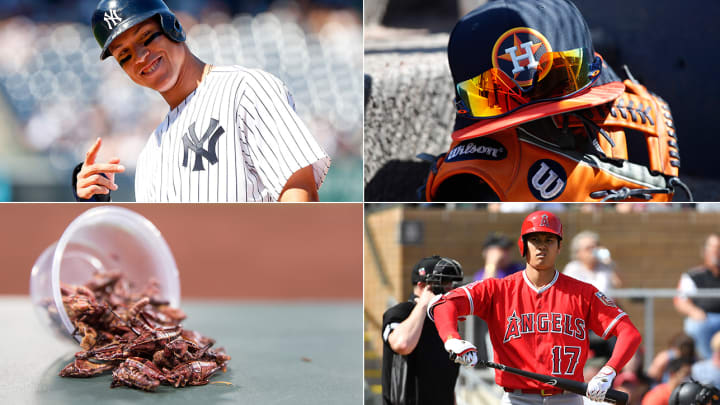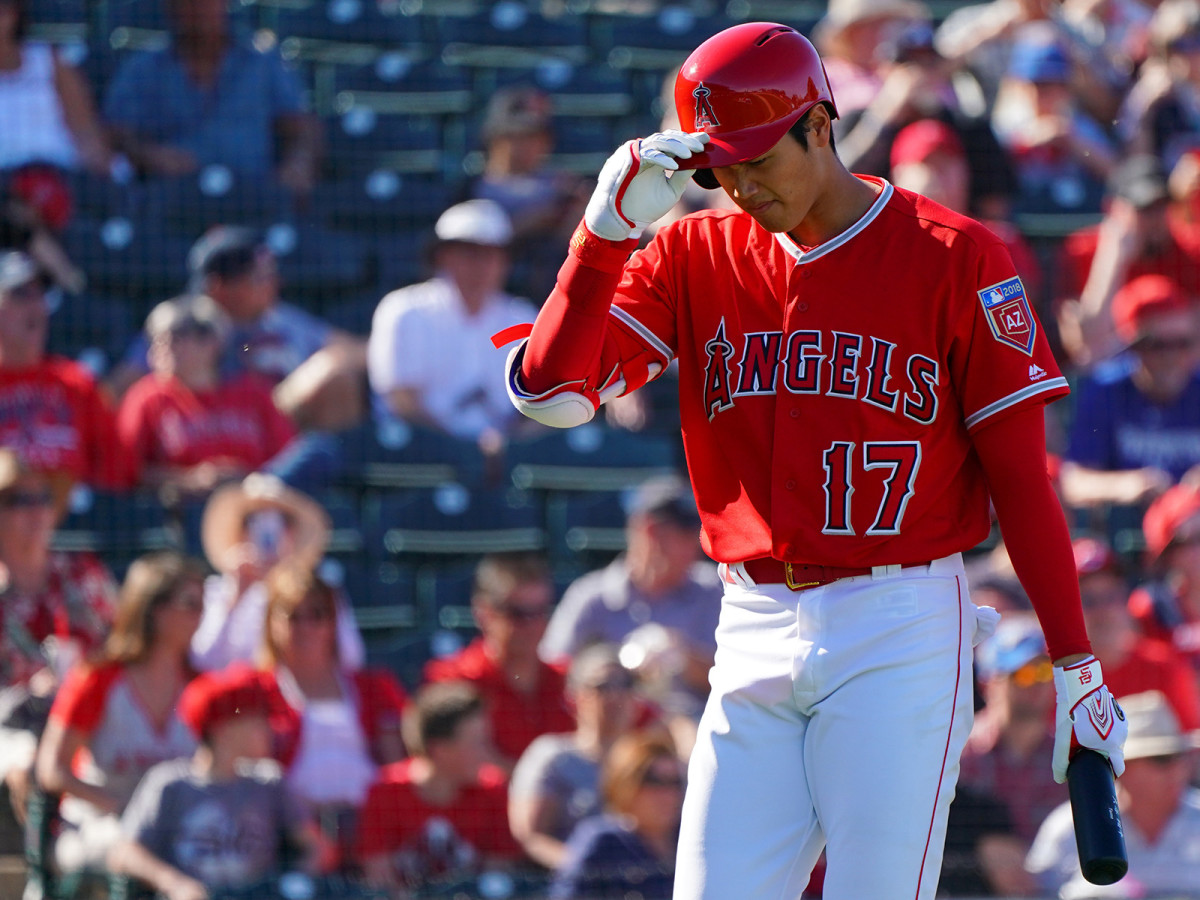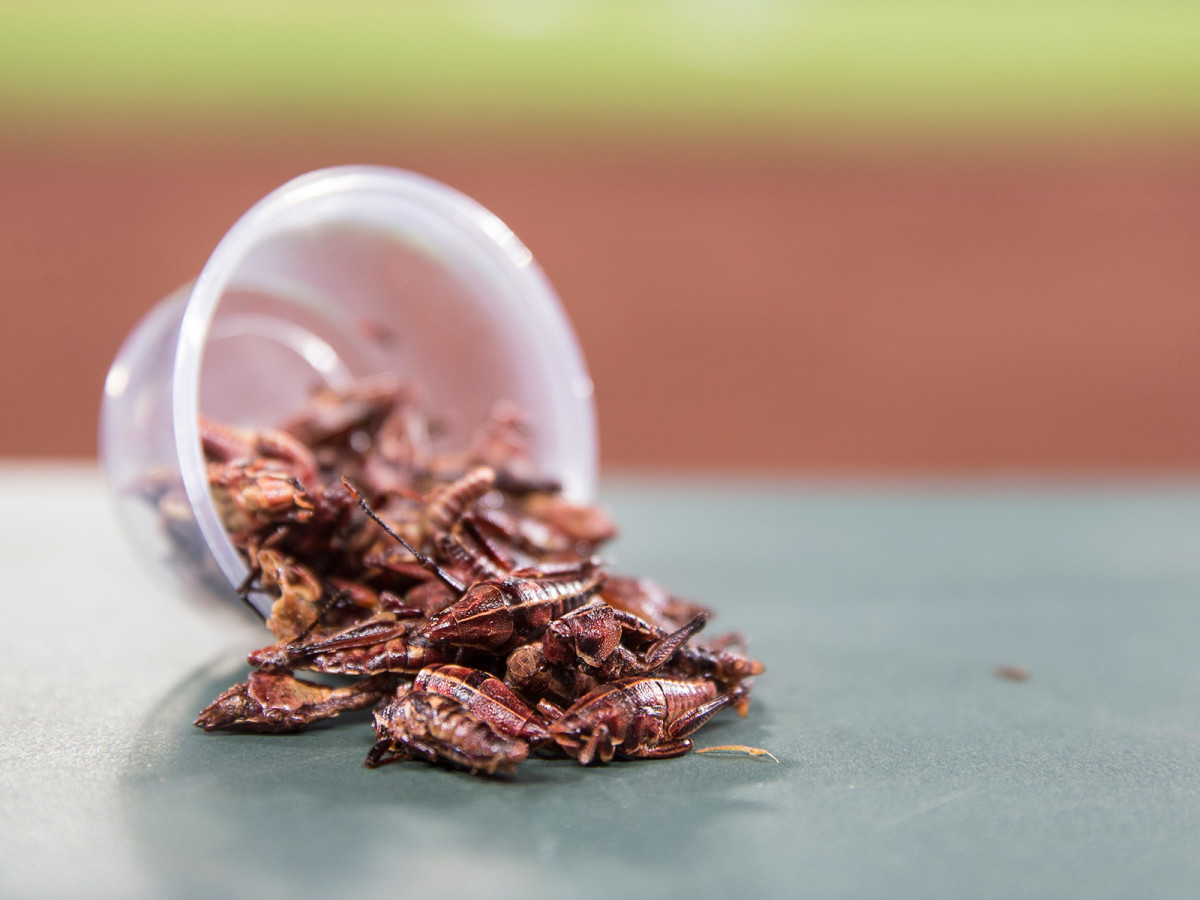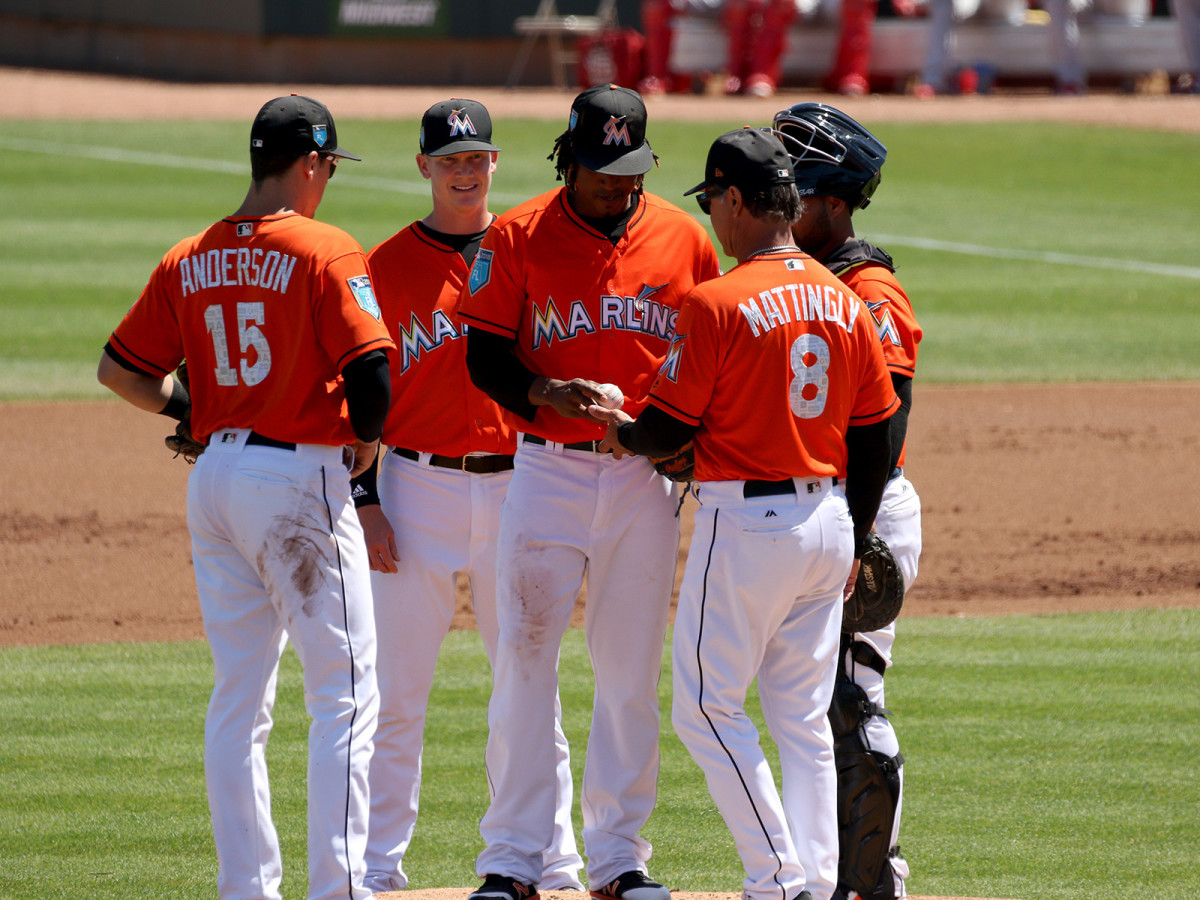Nine Innings: Finding the Yankees' Evil, Evaluating Ohtani's Woeful Spring and Ranking MLB Food Fest's Best Offerings

Editor's note: Welcome to SI's first edition of the Nine Innings column. Below you'll find a nine-part collaboration from our MLB staff, aiming to deliver the current pulse across Major League Baseball. You'll find sections that spotlight a player, team and division, a ranking of the nine best offerings at MLB's Food Fest, a roundtable on the new extra-innings rules in the minor leagues and more. Enjoy.
THE EVIL EMPIRE DIDN'T LIVE UP TO ITS NAME LAST YEAR, BUT IT'S GETTING THERE
By Stephanie Apstein
The most disturbing development of the 2017 baseball season wasn’t that Mike Trout missed six weeks with a thumb injury. It wasn’t the rash of pitchers felled by Tommy John surgery. It wasn’t the juiced ball, or the slick ball, or the increase in strikeouts and home runs and decrease in balls in play. The worst baseball thing that happened last year is that the Yankees got likable.
Everyone wants to talk about bat flips and pace of play, but this is a catastrophe. Aaron Judge grinning as he sentences yet another ball to the bleachers? Ronald Torreyes holding mock press conferences in the dugout (complete with a chewing-gum-container camera) after teammates’ home runs? Todd Frazier leading the team in a choreographed thumbs-down in response to key plays? No thank you.
Baseball needs heels, and there aren’t many clubs that have what it takes. The Dodgers have the wherewithal and high-salaried stars but not the championship pedigree. The Cubs and the Astros are potential dynasties in the making, but “potential” is all they have to work with for now. The Red Sox and Giants had a shot a few years ago but have since scuffled enough that a title would be more comeback than capstone. The Marlins are the underdog pick here, but it’s hard to feel anything other than sadness for the fans of that franchise. That leaves the Yankees. Alex Rodriguez’s retirement and the simultaneous bloom of several homegrown Bombers posed a real existential crisis for this franchise. But we know they can do it. Villainy is well within the Yankees’ reach.
How Giancarlo Stanton Negotiated His Way to the Yankees to Create Baseball's Scariest Lineup
Ownership is certainly trying, between their weird effort to crowd out people who buy tickets on the secondary market and their addition of the greatest slugger of his generation. (It’s great for this plotline, by the way, that they got him for basically nothing from a team run by Derek Jeter.)
The front office can’t do it alone, though. You need your Jeters and A-Rods, your Randy Johnsons and Roger Clemenses. Maybe even a Wade Boggs or two. So the best news of the glacially slow offseason was that Judge had been cited for tampering with Orioles shortstop Manny Machado—a free agent after this season—by telling him he’d look good in pinstripes. Imagine the 2019 3-4-5 of Machado-Stanton-Judge. It would be terrible for the rest of the league. That would make it great for the game.
WHAT TO MAKE OF SHOHEI OHTANI'S SPRING WOES

By Jon Tayler
Spring training stats don’t matter. For years, we’ve had that refrain beat into our heads, where it resides on loop alongside the lyrics to this generation’s worst pop songs and Marge Simpson’s emphatic reminder that this town is a part of us all. So with that in mind, is it worth worrying about Shohei Ohtani’s Cactus League struggles?
On the one hand, the Japanese star has looked thoroughly mortal in his first clash with major league hitters: In the two official starts he made in Arizona, he was blasted for eight runs and three homers and retired just eight of the 20 hitters he faced. On the other, five of those eight were strikeouts, with Ohtani showing off a dazzling array of breaking balls in particular. If you’re capable of snapping off something like this, why worry about how the rest of your day goes?
Shohei Ohtani, Kluberific Backdoor Slider. 🤢🚪 pic.twitter.com/qdtj2EMSl4
— Rob Friedman (@PitchingNinja) March 3, 2018
It’s likely that the Angels aren’t paying much, if any, attention to Ohtani’s ERA, and they shouldn’t. Nor is his performance necessarily an indicator that the young righty will be the biggest trans-Pacific bust since Hideki Irabu. But there are some stats that do raise questions. Chief among them is Ohtani’s velocity: For most of the spring, his fastball has averaged between 93–96 mph—plenty good, but nowhere near the triple digits he reportedly touched in Japan. In his final start of the spring in a game against minor leaguers, meanwhile, he couldn’t command his heater at all, walking five, hitting a batter and throwing two wild pitches. And as a hitter, Ohtani looks far from a finished product, picking up just three hits in 32 plate appearances and striking out nine times.
All of this should be expected from a 23 year old adjusting not only to a new league but a new country, and all the various changes that entails—different schedule, different balls, different mound, different teammates who are all better than even the best he faced back home. There was always going to be a learning curve for Ohtani, especially with his desire to hit and pitch, and while it’s premature to panic over the numbers, his spring is proof that greatness out of the gate is hard to achieve, even for those as talented as he is. For proof of that, Ohtani can turn to the future Hall of Famer in his clubhouse, Mike Trout, and ask him about hitting .220 in his first 40 games of his career.
QUICK HITS ON THE NL CENTRAL
By Jack Dickey
1. Credit to the Cubs for splurging on Yu Darvish. The team would have had plenty of cover had it bypassed free agency: Chicago won the Central fairly easily last year, and cautionary tales Ben Zobrist and Jason Heyward, the big fish of the 2015-16 offseason, will likely spend much of 2018 as backups. Instead they added the best starter available to a rotation that already had Jon Lester, Kyle Hendricks and Jose Quintana.
2. For my money, the Brewers were the biggest delight of 2017. Who knew Travis Shaw possessed such pluck! Christian Yelich and Lorenzo Cain, Milwaukee’s two major offseason acquisitions, represent a huge talent upgrade. But assuming last year’s club overachieved, the Brewers needed at least one starting pitcher, maybe two, to catch the Cubs. Jhoulys Chacin doesn’t cut it.
3. I can’t begin to imagine how we got here, but baseball is sleeping on the Cardinals. Sure, their bullpen is short a relief ace (and Mike Matheny will make that problem worse) but they project well in every other realm: Marcell Ozuna and Tommy Pham are stars; Carlos Martinez is a horse; there’s not a bad hitter anywhere in the lineup. I figure they’re a better bet to push Chicago than Milwaukee is.
The Pirates Could Have Been Contenders, but Ownership Cried Poverty and Betrayed Their Fans
4. The Pirates went all offseason without signing a major-league free agent, and they traded Gerrit Cole and Andrew McCutchen for some useful, non-transformative spare parts. It’s hard to know what Pittsburgh is betting on—even if their well-regarded bullpen surprises the league, how many leads will this punchless offense put them in position to protect?
5. Maybe all you need to know about the Reds is that Homer Bailey—who was last an above-replacement pitcher in 2014—is taking the hill for Opening Day. But their offense should be good, and the young rotation behind Bailey, because nothing whatsoever is expected of them, has at least the potential to surprise. (Seriously, brownie points to anyone east of Columbus or west of Louisville who can name the Reds' second, third, fourth or fifth starter.)
RANK 'EM: THE TOP NINE OFFERINGS AT MLB'S FOOD FEST

By Gabriel Baumgaertner
Major League Baseball is delivering the best eats from around baseball to New York City on April 21 and 22. Every team will showcase one of its local offerings, from the Mariners' toasted grasshopers to the Dodgers' Cheetos-covered elote. You can find every team's delicacy (if that's what you're calling a cheeseburger, Rockies) below. Here's my take on the top nine offerings at MLB Food Fest.
To celebrate the start of the 2018 season, MLB presents the first-ever #MLBFoodFest on April 21-22 in NYC, near Bryant Park. The one-of-a kind indoor food festival features special selections from each of the 30 Clubs served under one roof. https://t.co/TPYe1yKwej pic.twitter.com/6T6bMrEQG7
— MLB Communications (@MLB_PR) March 13, 2018
1. Bacon Wrapped Plantain — Miami Marlins: This is the most judicious and creative use of ingredients on this entire list: just a bacon-wrapped plantain would be enough. Add in the guava marmalade and the queso blanco and I’m in for several of these as well as the postgame bloating.
2. Toasted Grasshoppers — Seattle Mariners: Of course I want to try these. Unlike several of the disturbing nightmares that appear on this list (looking at you, Atlanta and your “Pig Pickin’”) the toasted grasshoppers might have some relative nutritional value. And then I could tell people that I once ate grasshoppers.
3. New England Lobster Rolls — Boston Red Sox: This is all about geography. I trust that the lobster shipped to the Red Sox is fresher than, well, anything that appears in any of the Midwestern offerings.
4. Chesapeake Waffle Fries — Baltimore Orioles: I’m very here for any Baltimore crab dips and its variants.
5. Crazy Crab Sandwich — San Francisco Giants: I’m unsure of how fresh the crab will be, but San Francisco-baked Sourdough bread is one of life’s great treasures.
6. Kurd Marczuk — Minnesota Twins: Breaded cheese curds and bratwurst topped with brown gravy? As long as somebody has antacids, I’m here to try it. I can feel my arteries hardening just reading this!
7. Adobo Bao — New York Yankees: Look: Bao is dank. The Yankees get props for trying a Chinese bun while its competitors are using different varieties of “cheese sauce.”
8. Chicken Shawarma Nachos — Detroit Tigers: Let’s hope the Tigers hired a chef from Dearborn—one of the most prominent Middle Eastern communities in the U.S.—so that the shawarma is authentic.
9. Classic NY Deli Pastrami Sandwich — New York Mets: L’Chaim! If you can’t appreciate good Jewish deli food, I can’t help you. Props to the Mets for trying to draw fans from the depths of Brooklyn with this offering.
ROUNDTABLE: WHAT DO YOU MAKE OF MINOR LEAGUE BASEBALL STARTING EXTRA INNINGS WITH A RUNNER ON SECOND?
By SI's MLB staff
Editor's note: Minor League Baseball announced a slew of rule changes earlier this month regarding pace of play. The most notable change comes in extra innings, where every half-inning after the ninth will begin with a runner on second base. We asked our Nine Innings contributors to evaluate this new mandate.
Stephanie Apstein: This is a bad idea. Baseball is the only major sport that stubbornly insists on rewarding goodness over hotness. There are no single-elimination tournaments (wild-card game notwithstanding) or expanded playoffs in which an eighth-place team can go on a run. This extends to overtime: No shootouts. No sudden death. Just more of the same thing we already did nine times, because that’s how you determine who ought to win. This is a good message in life and it is good for the sport. Leave extra innings alone. Extra innings are not the problem. The problem is that there are not enough balls in play. The result of this policy is that every extra inning will now begin with a bunt and/or an intentional walk. I’m sure that’ll get the kids begging to stay up late on a school night.
Gabriel Baumgaertner: Look, I’m supportive of baseball experimenting with new ideas for extra innings, I just don’t think it should exist at the higher ranks of the game. Rookie ball and Single-A ball should exist for experimentation. The players are young and more adaptable. The managers can manipulate the experimental rules to demonstrate their intelligence. At the Double-A and Triple-A level, however, it feels a bit exploitative. So many players are already surviving on insufficient wages trying to make the big leagues. The pressure is already incredibly high, and adding to that by putting a runner on second base is a bit cruel to a journeyman reliever trying to get out of Triple A at 27 years old.
The Greatest Curiosity: Shohei Ohtani Fashions the Angels Into Baseball's Most Interesting Team
Jack Dickey: The defining feature of the Rob Manfred era is MLB becoming more proactive. Bud Selig’s sclerotic approach to leadership ensured that any problem facing the game would go unresolved for at least a year or two, festering in the process. Manfred doesn’t do that; he is decisive. But a drawback of decisiveness is that you can wind up contorting yourself trying to solve issues that may not be issues at all. I don’t think there is a problem with extra-inning games taking too long, and certainly if there is, it isn’t a big one. But perverting the rules of the game, well, if such a rule change made its way to the major-league level… that’d rate as a big one.
Connor Grossman: It seems ironic that in a memo titled "MiLB announces pace-of-play rules for 2018," the first "pace of play" rule change listed in the release has nothing to do with that. Sure, a lot more games might end in the 10th inning as opposed to the 14th. But will the actual speed of the game increase, or will game times just decrease because of an artificial ending? I appreciate Rob Manfred's diligence on improving Major League Baseball's product, but this pie-in-the-sky idea diverges sharply from the issues at hand with pace of play.
Jon Tayler: Minor league baseball being used as an incubator for MLB’s wilder and dumber ideas is right in line with what the league seems to think of the minors as a whole: more project than product, like a lab experiment that can be altered on a whim. How else do you explain MLB’s callous indifference, if not outright hostility, to paying minor leaguers a fair wage? As for the rule itself: its effect on the game will be minimal, if felt at all, but it remains an odd idea—the product of a commissioner who seems to think improved pace of play means getting the whole thing over with earlier as opposed to more quickly.
TEAM SPOTLIGHT: THE ASTROS ARE READY FOR THEIR REGULAR-SEASON ROMP TO BEGIN
By Jon Tayler
This isn’t so much for anything special or unique the Astros have done this spring, but rather that they spent their month in Florida reminding the rest of the league how hard it’s going to be to topple them as the defending champions simply through their existence.
A rotation that already had Dallas Keuchel and Lance McCullers now gets Justin Verlander for a full season—oh, and Gerrit Cole, too. A lineup, meanwhile, that clobbered the rest of the league for nearly 900 runs and 238 homers—best and second-best, respectively, in baseball—last year lost exactly zero impact pieces, and all its best players are still firmly in their productive primes. Those facts are and would have been true no matter what Houston did over the spring, barring a team-wide outbreak of malaria. The rest of the AL West had no such luck: The Astros came to camp, got through it healthy, and are set to run amok on the division and likely the postseason, too. Consider the regular season a kind of extended spring for them, then—a tune-up for the month that will matter most.
BOX SCORE LINE OF THE SPRING: IT'S GOING TO BE A LONG YEAR IN MIAMI

By Connor Grossman
It goes without saying, but spring training numbers don't count for anything. That doesn't mean they don't exist, though. Our box score line of the spring, with a hat tip to The Athletic's Jayson Stark, goes to the Marlins starter Jose Ureña. He turned in a destructive, one-out performance against the Cardinals on March 14 that's probably more indicative of the year his team, not necessarily himself, is about to endure.
Ureña vs. St. Louis: 0.1 Innings, 6 Hits, 6 Earned Runs, 2 Walks, 1 Strikeout
According to the box score, the game ominously began with Dexter Fowler singling "on a popup to shortstop." Ureña bounced back and struck out Tommy Pham looking, recording his first and last out simultaneously. Matt Carpenter walked to put two runners on, and the rout commenced with back-to-back-to-back doubles. Three more Cardinals reached base before manager Don Mattingly stopped the madness by removing his Opening Day starter.
Yes, you read that correctly. Jose Ureña is the Marlins Opening Day starter. He's a decent pitcher who finished last season with a 3.82 ERA in 169 2/3 innings. It's still going to be an awfully long summer in Miami.
OUR BEST STORIES TO PREPARE YOU FOR OPENING DAY
— Right now, it's all about launch angle. To understand how the baseball swing has changed and what the future of the game will look like, Tom Verducci's opus on the modern baseball swing is essential reading.
— Pair that with the shorter item on how Wil Myers, always a trusty gap-to-gap hitter, conceded that he too needed to boost the hitch in his swing.
— Giancarlo Stanton knew he had leverage, and he executed it by securing his trade from the Marlins to the Yankees. Ben Reiter details how the game's most feared slugger didn't back down from Marlins ownership to get what he wanted.
— After losing 98 games last year, the Giants probably should have started rebuilding instead of trying to compete this season. Their 2018 hopes took a serious blow after losing Madison Bumgarner to a hand injury in his final spring training start.
— All eyes will be on Shohei Ohtani as he tries to become the game's first feared two-way player of the generation. His presence makes the Angels baseball's most interesting team according to Stephanie Apstein.
PAYOFF PITCH: IT'S TIME TO START THE SEASON
Don't just take it from us. Brandon Finnegan clearly thinks it's time for spring training to finally end.
Don't worry, @bfinny29. It's Spring Training for all of us: https://t.co/Gh1xRDqboZ pic.twitter.com/iBFaYok7Dt
— Cut4 (@Cut4) March 25, 2018
